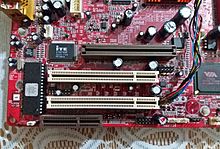Accelerated Graphics Port
Accelerated Graphics Port 
|
|

Universal AGP slot (brown, top) and PCI 2.2 slot (white beige, bottom)
|
|
| Year created | 1996 |
|---|---|
| Created by | Intel |
| Superseded by | PCI Express (2004) |
| Width in bits | 32 |
| No. of devices | One device per slot |
| Speed | Up to 2133 MB/s |
| Style | Parallel |
The Accelerated Graphics Port (AGP) is a high-speed point-to-point channel for attaching a video card to a computer system, primarily to assist in the acceleration of 3D computer graphics. It was originally designed as a successor to PCI-type connections for video cards. Since 2004, AGP has been progressively phased out in favor of PCI Express (PCIe); by mid-2008, PCI Express cards dominated the market and only a few AGP models were available.
As computers increasingly became graphically oriented, successive generations of graphics adapters began to push the limits of PCI, a bus with shared bandwidth. This led to the development of AGP, a "bus" dedicated to graphics adapters.
AGP is heavily based on PCI, and in fact the AGP bus is a superset of the conventional PCI bus, and AGP cards must act as PCI cards.
The primary advantage of AGP over PCI is that it provides a dedicated pathway between the slot and the processor rather than sharing the PCI bus. In addition to a lack of contention for the bus, the direct connection allows for higher clock speeds.
The second major change is that AGP uses split transactions, where the address and data phases of a PCI transaction are separated. The card may send many address phases, and the host processes them in order. This avoids long delays, with the bus idle, during read operations.
Third, PCI bus handshaking is simplified. Unlike PCI bus transactions whose length is negotiated on a cycle-by-cycle basis using the FRAME# and STOP# signals, AGP transfers are always a multiple of 8 bytes long, and the total length is included in the request. Further, rather than using the IRDY# and TRDY# signals for each word, data is transferred in blocks of four clock cycles (32 words at AGP 8× speed), and pauses are allowed only between blocks.
Finally, AGP allows (optional in AGP 1.0 and 2.0, mandatory in AGP 3.0) sideband addressing, meaning that the address and data buses are separated so the address phase does not use the main address/data (AD) lines at all. This is done by adding an extra 8-bit "SideBand Address" bus over which the graphics controller can issue new AGP requests while other AGP data is flowing over the main 32 address/data (AD) lines. This results in improved overall AGP data throughput.
...
Wikipedia
